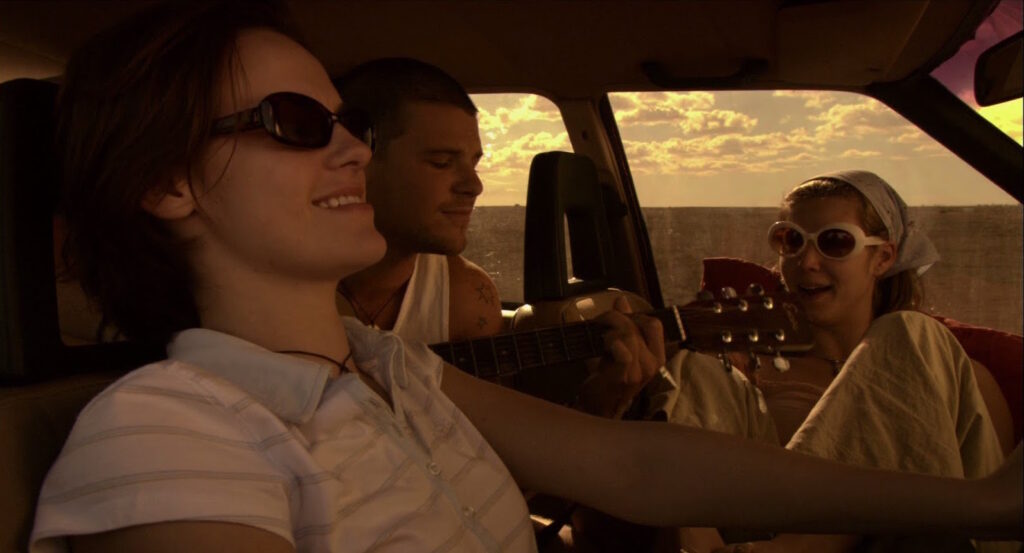Horror films often pique our deepest curiosity. Some films tease us with ghosts or supernatural creatures, but every so often, a movie comes along that feels far too real for comfort. The Wolf Creek movie is one of those rare experiences. It isn’t simply whispered about in horror circles—it’s spoken of with a kind of nervous respect, the way you might discuss a near-death experience you’d rather not relive.
Unlike many forgettable slashers, Wolf Creek doesn’t rely on cheap tricks. Instead, it builds an atmosphere so oppressive that by the time the violence arrives, you’re already unsettled. Director Greg McLean transforms the sunlit beauty of the Australian Outback into a wasteland of psychological torture, where survival isn’t just uncertain—it’s nearly impossible.
At the center of it all is Mick Taylor, brought chillingly to life by John Jarratt. He’s not the masked, cartoonish killer of Hollywood slashers; he’s the smiling neighbor, the charismatic bushman whose effortless charm curdles into sadism. His menace lies in his believability—he is the monster that could live next door.
And here’s the hook that makes Wolf Creek so unforgettable: it’s inspired by true events. Borrowing threads from the notorious cases of Ivan Milat and Bradley Murdoch, the film draws its horror from reality itself. It forces audiences to confront the question they don’t want answered: Could these events really happen?
The Wolf Creek movie is not just another horror film review—it’s a journey into the heart of one of the most disturbing Australian horror movies ever made. So buckle up. The road into Wolf Creek is long, brutal, and impossible to forget.
Welcome to the Killing Floor: How Wolf Creek’s Plot Lures You into a Savage Trap
Forget everything you know about the slasher genre film. Director Greg McLean doesn’t just break the rules; he sets them on fire. The setup is deceptively, agonizingly simple. Three vibrant, likable backpackers—two British girls, Liz and Kristy, and their Aussie mate, Ben—are on an epic road trip across the vast, breathtaking, and empty Australian Outback.
The first act masterfully lulls the audience into a false sense of security. We get to know them. They laugh, they flirt, and they bond under the immense outback sky. You like these people. This deliberate, docu-style setup isn’t just building atmosphere; it’s building empathy. Then, the harsh reality sets in. Their car breaks down. Stranded under a merciless sun, hope arrives in the form of Mick Taylor—a jovial, crocodile-hunting bushman who seems like a gift from the gods.
This scene is where the psychological horror


The REAL Backpacker Murders: The Chilling True Story Behind the Wolf Creek Movie
So, let’s answer the question that fuels the film’s terrifying engine: Is the Wolf Creek movie based on a true story?
The film opens with the stark, chilling title “Based on Actual Events.” This is not a gimmick. It’s a promise of the nightmare to come. Yes, the answer is nuanced, and therefore more frightening.
Greg McLean didn’t adapt a single headline. Instead, he weaponized the collective trauma of Australia’s most notorious backpacker murders. Wolf Creek movie is a Frankenstein’s monster, stitched together from the country’s darkest true-crime archives, making it a definitive, based on actual events horror experience.
The Ghost of Ivan Milat: The Backpacker Murderer Who Terrorized a Nation
The primary blueprint for Mick Taylor is the Ivan Milat case. Between 1989 and 1992, Milat brutally murdered seven young backpackers in the Belanglo State Forest. His method of operation was a real-life horror script: he would pose as a friendly local, offer assistance to travelers with car trouble, gain their trust, and then lead them to a remote location for torture and murder. The backpacker murders Australia endured during this period left a permanent scar on the national psyche, forever corrupting the image of the helpful bushman.
Deepening the Terror: The Bradley Murdoch Case and Snowtown Killers Connection
The film’s contemporary fear factor was fueled by the Bradley Murdoch case—the 2001 murder of British tourist Peter Falconio in the remote Outback. Furthermore, the grim, rural sadism echoes the Snowtown killers’ connection, another chapter of profound Australian darkness. By synthesizing these real-life monsters into the singular, iconic figure of Mick Taylor, McLean didn’t just make a movie; he bottled the existential dread every traveler feels when their engine sputters on a deserted road, creating a potent and controversial piece of exploitation cinema.
The Faces of Fear: A Cast That Sold the Ultimate Nightmare
The raw, believable performances of its cast cement the power of the Wolf Creek movie. The absence of Hollywood stars amplifies the terrifying realism.
John Jarratt IS Mick Taylor: The Anatomy of a Perfect Monster
Forget Freddy. Forget Jason. The most terrifying monsters are human. John Jarratt’s performance as Mick Taylor is a masterclass in villainy. Jarratt, known for his light-hearted TV work, completely inverts his persona to create an iconic psycho-killer archetype.
His Mick Taylor is a brilliant, hateful subversion of the chirpy Aussie yomping bushman—a Steve Irwin’s sadistic, Satanic uncle. He’s charismatic, with a grating laugh that disarms you. But in a heartbeat, that grin twists into a rictus of pure malice. His eyes go dead. Jarratt masterfully controls this terrifying seesaw. The script underscores the event with a bone-chilling Crocodile Dundee reference—”That’s not a knife… this sight is a knife”—a moment that is both horrifying and, guiltily, one of the film’s most memorable. Any analysis of Mick Taylor’s character in the Wolf Creek movie must conclude that Jarratt didn’t just play a role; he created a new sadistic killer trope rooted in terrifying plausibility.
More Than Just Victims: The Raw Humanity of McGrath, Morassi, and Phillips

The brilliance of the Wolf Creek movie cast is that we genuinely care about the prey. Cassandra Macgrath (Liz) and Kesti Morassi (Kristy) deliver performances grounded in authentic terror and desperation. They are not scream queens; they are fighters, and their struggle is visceral and heartbreaking. Nathan Phillips as Ben provides the crucial, easy-going Aussie charm that makes the group’s fate so much more devastating. The distressing brutality of the film’s second half is powerfully conveyed by this trio.
From Low-Budget Grit to Cinematic Landmine: How Wolf Creek Redefined Terror
The genius of Wolf Creek lies in its execution. Crafted on a modest budget, Wolf Creek eschews Hollywood glamour in favor of a raw, Dogme 95-style filmmaking aesthetic. Shot on hi-def DV, the film feels like a found-footage snuff film. The camera work is unsteady, the sound design is a symphony of brutality, and the Australian Outback itself is the most potent character—a beautiful, empty, and utterly indifferent deathtrap. This low-budget horror approach is the key to its power. It feels real. It feels like something that could have happened, which is why the violence in cinema debate it sparked was so fierce.
Crossing the Line: The Unflinching Misogyny and Violence That Still Sparks Global Outrage
To dismiss Wolf Creek as mere torture porn is to misunderstand its power, even if that power is deeply uncomfortable. The film forces a confrontational conversation about violence in cinema and, specifically, its preference for female suffering.
The Wolf Creek movie delves deeply into the long-debated topic of misogyny in horror films. The infamous “Head on a stick” Wolf Creek scene is not just a moment of shocking gore; it’s a deeply symbolic act of dehumanization. The film’s unwavering emphasis on the brutalization of its female characters creates a deeply unsettling misogynist undercurrent, which many critics found more disturbing than the actual bloodshed.
This feature is a deliberate, controversial choice. By making the violence so personal, cruel, and gendered, McLean forces the audience to not just be scared but to be repulsed and outraged. He blurs the boundaries, compelling you to contemplate your own boundaries. The film succeeds as a grim, gut-chiller precisely because it forces you to look away.
The film’s cultural impact was immediate and profound. Jokes about it “giving Australia’s Outback tourism industry a bad case of heartburn” weren’t just funny; they were proof of the film’s power to alter perception, cementing its status as a landmark of disturbing horror movies.
The Critic Divide: How Wolf Creek Movie Splits Audiences Down the Middle
Upon its release, Wolf Creek didn’t just terrify; it polarized. The Wolf Creek Rotten Tomatoes page became a battleground, where it still holds a shockingly high “fresh” rating.
- Some praised it as a masterpiece of tension. The Hollywood Reporter called it “bound to give even the most seasoned thriller seeker nightmares.”
- Others condemned its soul. The BBC’s Matthew Leyland led the Wolf Creek misogyny criticism, arguing its “preference for female suffering” created an “unsettling undertow.”
This debate is the film’s enduring legacy. Is it a masterclass in true crime-inspired horror or an exploitation horror genre exercise in cruelty? The fact that we’re still arguing about it years later is a testament to its raw, uncompromising power.
In the final analysis, Wolf Creek Movie remains a brutally effective psycho-killer thriller. It’s a difficult, distressing, and masterfully crafted film that uses its true crime-inspired roots not as a gimmick, but as a weapon to dismantle the audience’s sense of safety. It features one of cinema’s finest monsters in John Jarratt’s Mick Taylor and stands as a raw, uncompromising landmark of Australian horror. You don’t just watch the Wolf Creek movie; you survive it. And its scars, like the vast, silent emptiness of the Outback itself, linger long after the credits have rolled.
